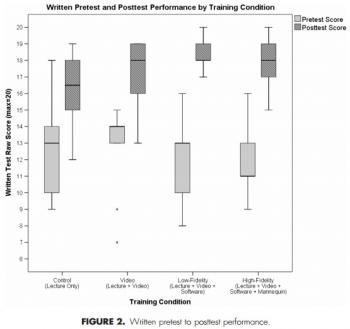19/08/2015
Simuler en haute fidélité: Pas si sûr !
A Comparison of Teaching Modalities and Fidelity of Simulation Levels in Teaching Resuscitation Scenarios
Adams AJ et Al. J Surg Ed 2015, 72:778-785
-------------------------------
Il existe un très grand engouement pour le recours à la simulation haute fidélité, ce qui n'est pas sans impact financier. Un mannequin sophistiqué serait le gage d'une meilleure qualité de formation. Il semble que les bases scientifiques de ces démarches ne sont pas aussi solides que cela du moins pour les novices. Cet article a le mérite de montrer que l'on peut parfaitement conduire une formation de qualité avec des moyens plus conventionnels.
-------------------------------
Introduction
The purpose of our study was to examine the ability of novices to learn selected aspects of Advanced Cardiac Life Support (ACLS) in training conditions that did not incorporate simulation compared to those that contained low- and high-fidelity simulation activities. We sought to determine at what level additional educational opportunities and simulation fidelity become superfluous with respect to learning outcomes.
Methods
Totally 39 medical students and physician assistant students were randomly assigned to 4 training conditions: control (lecture only), video-based didactic instruction, low-, and high-fidelity simulation activities. Participants were assessed using a baseline written pretest of ACLS knowledge. Following this, all participants received a lecture outlining ACLS science and algorithm interpretation. Participants were then trained in specific aspects of ACLS according to their assigned instructional condition. After training, each participant was assessed via a Megacode performance examination and a written posttest.
Results
All groups performed significantly better on the written posttest compared with the pretest (p < 0.001); however, no groups outperformed any other groups. On the Megacode performance test, the video-based, low-, and high-fidelity groups performed significantly better than the control group (p = 0.028, p < 0.001, p = 0.019). Equivalence testing revealed that the high-fidelity simulation condition was statistically equivalent to the video-based and low-fidelity simulation conditions.
Conclusion
Video-based and simulation-based training is associated with better learning outcomes when compared with traditional didactic lectures only. Video-based, low-fidelity, and high-fidelity simulation training yield equivalent outcomes, which may indicate that high-fidelity simulation is superfluous for the novice trainee.


Les commentaires sont fermés.